Who does the control of asbestos regulations apply to?
Written by Femi
Lawore Femi, Digital Sales Optimiser.
Contents are researched and analysed to meet good standards
Asbestos is a dangerous material that can cause serious health problems. That’s why there are laws in place to keep people safe from it. These laws, called the “asbestos regulations,” apply to different people based on their job or situation.
In order to minimise risks, the Control of Asbestos Regulations (CAR) have strict rules around asbestos management and removal.
But who exactly do these asbestos regulations apply to? They are called asbestos ‘dutyholders’.
This refers to any owner or manager – whether private, public, or non-profit – with maintenance accountability for buildings containing asbestos.
This article will explain which individuals and businesses have duties under CAR.
Control of Asbestos Regulations makes necessary laws and rules for controlling it, protecting people from its harmful effects.
They dictate safe handling, removal, and removal practices. This ensures worker and public safety.
These regulations are essential in preventing asbestos-related health risks and promoting a safer environment in various settings.
What we covered:
- What is the control of asbestos regulations
- Control of Asbestos Regulations 2012
- Categories under regulation: duty holders and employers
- Duty Holders
- Employers
- Organisation subject to Asbestos regulations
- Individual subject to Asbestos Regulations
- Licensed Asbestos Removal Procedures
- Penalties for Control of Asbestos Regulations 2012 non-compliance
- Why Asbestos is Still a Problem?
- Regulations Protecting Everyone From Asbestos Exposure
- Control of Asbestos Regulation 2012
- Previous Asbestos Regulation before CAR 2012
Who Asbestos Regulations Apply To
The main responsibility falls on any building owner or manager (whether private home, company office, school) in charge of places containing asbestos. They are the duty holder with responsibilities that asbestos law apply to.
Essentially whoever manages property upkeep must ensure people inside interact safely with any asbestos currently or in future.
They get professional checks, seal the place and break the building down.
Rules by law require basic repair and repair workers (e.g. builders, plumbers, painters) working around old hidden asbestos get training to avoid health harms.
Moreover, when large construction worker work on projects that might disturb old asbestos in destroyed buildings, they need special training to handle it safely.
Building Owners and Managers:
If you own or manage a building, you have a responsibility to make sure anyone who uses it is safe from asbestos.
This includes homes, offices, schools, and even very old buildings.
You need to:
- Get the building checked for asbestos by a professional.
- Seal off any asbestos that is present to prevent people from breathing the dust.
- Remove asbestos completely if it is damaged or poses a risk.
- Follow the regulations for safe work practices if you need to disturb asbestos.
Tradespeople and Contractors:
If you work on buildings, you might come across asbestos without even knowing it.
That’s why the law require you to take asbestos awareness training. This training teaches you how to identify asbestos and stay safe if you find it.
Demolition and Construction Companies:
If you do large building work, you might need even more training.
If you remove asbestos, you or someone on your team needs to be a certified asbestos removal manager.
This makes sure the work is done safely and according to the law.
Everyone Has a Role:
While these rules focus on specific groups, everyone can help reduce the risk of asbestos contact.
If you suspect asbestos in a building, report it to the appropriate authorities.
By working together, we can keep everyone safe from this hidden danger.
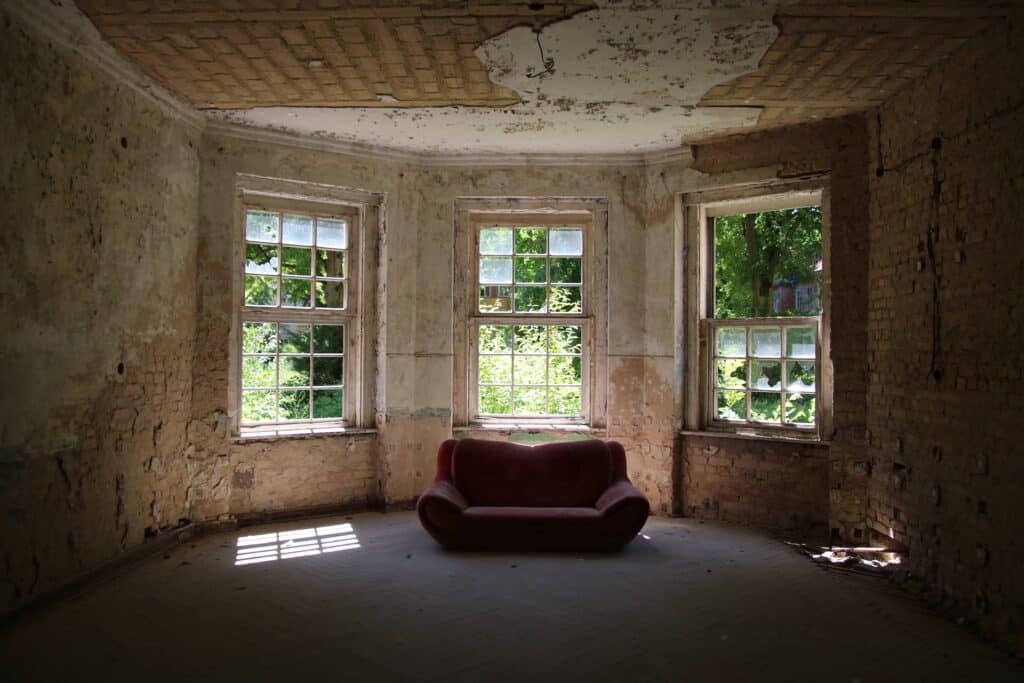
About Asbestos Rules in the UK
Remember that asbestos is a dangerous material used in older buildings for its strength and fire resistance.
However, it can also cause serious health problems if inhaled.
These tiny fibers can get stuck in your lungs and lead to diseases like lung cancer or mesothelioma, even years later.
Why the Law Exists
In the past, many people who worked on buildings built between the 1940s and 1980s were at high risk from asbestos exposure.
Even low levels of contact over time could be harmful, like for school staff without knowing breathing in dust from fallen walls.
By 2007, this was causing a lot of deaths, so the government created the Control of Asbestos Regulations in 2012.
What the Law Does
- Protects people: This law makes building owners find and manage any asbestos properly. This involves sealing it off, marking it clearly, and removing damaged asbestos quickly.
- Raises awareness: Anyone working on buildings like demolition crews, repair workers, or even maintenance staff needs special training to understand the risks and how to stay safe.
Real-Life Example: School Asbestos
In 2015, a school built in the 1960s found asbestos in its walls and ceilings. This meant they had to follow strict rules, including:
- Closing affected areas until tests showed safe air quality.
- Removing parts of the ceiling by trained professionals wearing protective gear.
- Clearly marking all remaining asbestos and checking it regularly for damage.
- Training all staff on the risks and how to act safely.
Staying Safe
Following these rules helps prevent people from breathing in asbestos dust.
Regular checks and careful repairs or removals further reduce the risk of getting sick.
While asbestos was widely used in the past, managing it properly now protects both current and future generations from harm.
What is the Control of Asbestos Regulations?
The Control of Asbestos Regulations are rules by the British government to manage the dangers of asbestos exposure.
They guide how to find, assess, and handle items with asbestos in various settings.
The rules cover surveys, risk assessments, training, and safe disposal of asbestos waste. The aim is to protect people from the health risks of asbestos materials.
These asbestos regulation tell people:
- Find it: Check buildings to see if the dust is there.
- Handle it carefully: Seal it up or get rid of it properly, not just sweep it under the rug!
- Learn about it: Train people working in buildings so they know the dangers and stay safe.
- Get rid of it the right way: Throw it away carefully so it doesn’t hurt anyone.
These set of rules protect everyone. From people who live or work in buildings with asbestos to workers who might fix them.
They’re important because:
- They stop people from getting sick.
- They give everyone peace of mind.
- They’re the law!
Control of Asbestos Regulations 2012
The Control of Asbestos Regulations 2012 is a UK law focused on managing asbestos risks, especially in older buildings containing asbestos materials.
Some key points about the asbestos regulations:
Some key points about the asbestos regulations:
- Introduced in 2012 to update and combine previous asbestos rules into one consistent framework.
- Aims to prevent illness from inhaling asbestos fibers which can cause serious lung diseases like mesothelioma over time.
- Sets duties for those managing properties to identify asbestos through building surveys, create risk plans, have procedures for accidents, and provide specialised safety training.
- Requires following best work practices to control or remove materials in a way that minimises asbestos materials release during any repairs, upgrades or demolition including strict waste disposal.
- States asbestos removal companies and supervisors must be licensed, and workers certified by approved UK organisations on safe techniques.
- Covers all work sectors – commercial, industrial, public – to ensure properties comply regarding both staff safety and wider public exposure to degraded revealed asbestos.
Regardless of the business or industry, the Control of Asbestos Regulations 2012 cover all commercial, factories, and public structures, including:
- Schools, colleges and universities
- Hospitals, clinics, and health care facilities
- Private and public offices
- Retail businesses like stores, restaurants, hotels
- Transportation facilities and vehicles
- Religious centers
- Leisure and entertainment venues
In essence, any business building used for work, commercial or public activities falls under the laws. This also includes the common areas of rented local properties.
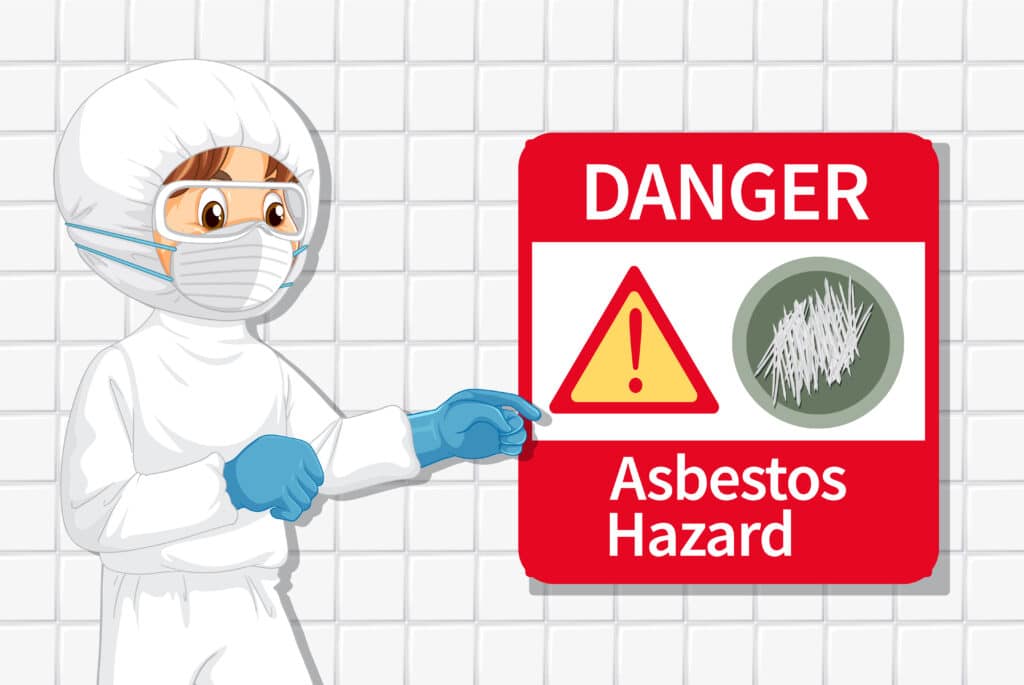
Categories under Regulation: Duty Holders and Employers
1. Duty Holders
The ‘Duty Holder’ is the person in control for keeping and managing a building. This is usually the owner, landlord, facilities manager, or person in charge of the building.
Regulation 4 of the Control of Asbestos Regulations 2012 requires the duty holder to:
- Take standard steps to find and see any asbestos or asbestos items present in the building(s) they are responsible for.
- Consider the condition of any risk.
- Suppose materials contain asbestos unless testing proves otherwise.
- Maintain a register listing type, size, and condition.
- Have a plan to control asbestos risks by repair, removal, closing the place etc.
- Share the asbestos register with anyone who may disturb it.
These duties apply to any non-domestic building built before 2000 and aim to stop experience.
2. Employers
Under Control of Asbestos Regulation 2012, employers have duties to protect their employees from asbestos, including:
- Ensuring employees who may come in contact have asbestos awareness training.
- Providing proper PPE as needed.
- Having disaster actions plan in case of trouble.
- Ending work if employees may disturb or damage it.
- Following all legal rules around approved asbestos removal.
Employers must work fully with Duty Holders to gain asbestos data and work safely in place.
Enroll Now!
Asbestos Awareness Online Course
Organisations Subject to Asbestos Regulations
The Control of Asbestos Regulations place legal duties on several organisations that own, maintain, or work with asbestos in work location.
These include:
Building Owners and Facility Managers
Building owners or facility managers have a ‘duty to manage’ asbestos. These duties aim to protect workers and occupants from asbestos exposure risks.
According to the Control of Asbestos Regulations (CAR) 2012, building owners and facility managers have the following legal duties:
- Identify and locate any asbestos or asbestos-containing materials in the building(s) they are responsible for. This requires asbestos surveys.
- Presume materials contain asbestos unless testing proves otherwise.
- Maintain an up-to-date asbestos register detailing the location, type and condition of asbestos.
- Assess the risk from any identified asbestos materials.
- Have a plan to manage asbestos risks through removal, enclosure, repair etc.
- Ensure the asbestos register is shared with anyone who may work on or disturb asbestos at the site.
- Review and monitor the condition of asbestos periodically.
- Arrange safe removal or remediation of deteriorating asbestos.
- Follow all legal obligations for licensed asbestos removal if undertaken.
Employers
Employers must protect their staff from the risks of asbestos exposure. The primary responsibility for the well-being and safety of employees concerning asbestos lies with the employers.
According to the Control of Asbestos Regulations (CAR) 2012, employers have the following legal obligations:
- Ensure employees who may encounter asbestos receive adequate asbestos awareness training.
- Provide proper respiratory protective equipment to employees as required.
- Have emergency procedures in place in case of accidental asbestos disturbance.
- Stop any work by employees if it is likely to disturb or damage asbestos-containing materials.
- Follow all legal protocols around licensed asbestos removal using licensed contractors.
- Prevent employees from carrying out unlicensed asbestos removal.
- Ensure employees follow safe work practices around asbestos.
- Collaborate with building owners/managers to access asbestos information.
- Maintain health records for employees exposed to asbestos.
- Report cases of diseases linked to asbestos exposure.
Asbestos Removal Companies
Licensed asbestos removal companies must follow stringent procedures to safely contain, remove and dispose of asbestos while protecting workers and the public.
They are highly regulated given the dangerous nature of their work.
According to the Control of Asbestos Regulations 2012, asbestos removal companies have the following key duties:
- Be licensed by the Health and Safety Executive (HSE) to conduct asbestos removal work.
- Submit a plan before undertaking any licensed asbestos removal describing methodology, equipment, waste disposal etc.
- Use only trained employees who have had medical examinations and fit testing for proper respirators/PPE.
- Follow notification procedures before and after doing licensed work.
- Use appropriate techniques like wetting asbestos, using enclosures, and negative air pressure.
- Prevent release and spread of asbestos fibers during removal work.
- Safely package and label asbestos waste for disposal at approved sites.
- Clean work areas thoroughly using specialist equipment like vacuum cleaners and air monitoring.
- Provide reassurance air testing and certificates on successful clearance of work areas.
- Follow all other regulations set out for licensed contractors and asbestos removal.
Asbestos Surveyors
Accredited asbestos surveyors identify and assess asbestos materials through proper checks
They provide clients with reports on asbestos presence and advise on appropriate control measures.
According to the Control of Asbestos Regulations 2012, asbestos surveyors have the following duties:
- Be trained and accredited by UKAS approved organizations to identify and sample asbestos materials.
- Inspect properties and assess if asbestos-containing materials are present.
- Presume materials contain asbestos unless testing proves otherwise.
- Take samples for laboratory analysis if required.
- Identify the location, type, condition and extent of any asbestos found.
- Assess the level of asbestos risk through factors like material damage, accessibility, and fiber release potential.
- Provide a written report to clients detailing asbestos present and recommended actions like further sampling, monitoring, removal etc.
- Follow safety procedures when disturbing asbestos to take samples.
- Recommend options for control, repair, encapsulation or licensed removal of identified asbestos.
Individuals Subject to Asbestos Regulations
In addition to organizations, the CAR rules also apply to individuals who work with or may disturb asbestos. These include:
Maintenance Workers
Maintenance workers must avoid any work on asbestos materials unless trained and follow procedures to prevent accidental exposure for themselves and building users. They need awareness to identify asbestos risks.
According to the Control of Asbestos Regulations 2012, maintenance workers have the following duties related to asbestos:
- Complete asbestos awareness training to recognize and avoid asbestos.
- Check the asbestos register before any work that may disturb building fabric.
- Presume materials contain asbestos unless confirmed otherwise by testing.
- Stop work immediately if materials are uncovered that may contain asbestos.
- Not work on asbestos-containing materials unless trained, competent and have appropriate PPE.
- Follow safety protocols if asbestos is accidentally disturbed.
- Undergo medical surveillance if carrying out notifiable non-licensed asbestos work.
- Attend refresher asbestos awareness courses as required.
- Report any concerns about condition of asbestos materials.
- Avoid activities like drilling holes that may damage sealed asbestos.
Construction Workers
Construction workers must not disturb asbestos and must use approved contractors for asbestos solutions.
They need training to identify risks.
According to the Control of Asbestos Regulations 2012, construction workers have the following asbestos-related duties:
- Ensure any buildings they are working on have had a recent asbestos survey completed.
- Check the asbestos register before starting work and presume materials contain it.
- Stop all work immediately if unknown materials are discovered that could contain it.
- Avoid any activities that may disturb or damage asbestos-containing materials.
- Follow safety procedures if asbestos is accidentally touched during their work.
- Only allow permitted asbestos removal contractors to undertake any asbestos removal required.
- Prevent unlicensed removal of asbestos by their staff or sub-contractors.
- Follow all control measures and exclusion zones if approved asbestos removal is taking place.
- Undergo asbestos awareness training to recognize potential asbestos.
Electricians
Electricians should presume asbestos presence and avoid contact during their work unless testing confirms asbestos-free materials.
Proper procedures must be followed if asbestos is noticed.
According to the Control of Asbestos Regulations 2012, electricians have the following asbestos duties:
- Presume any equipment or materials they work on contain asbestos unless proven otherwise. This is especially important for older wiring insulation and fuse panels.
- Check the asbestos register and request testing to confirm or refute asbestos presence if working on older electric systems.
- Cease work immediately if it is discovered or presumed in electrical panels, wiring etc.
- Avoid damage to asbestos-containing materials like insulated pipes or ceiling tiles when installing cables.
- Follow safety procedures if asbestos is accidentally disturbed during electrical work.
- Only allow licensed asbestos removal contractors to undertake any asbestos solution required during electrical upgrades or maintenance.
- Undergo asbestos awareness training to recognize materials that may contain asbestos.
Plumbers
Plumbers should assume asbestos presence when working on older systems and must avoid disturbance. Proper procedures need to be followed if asbestos is encountered during plumbing work.
According to the Control of Asbestos Regulations 2012, plumbers have the following asbestos duties:
- Presume asbestos is present in any pipe insulation, water tanks, boilers or other equipment worked on, especially in older systems.
- Check the asbestos register and request testing before working on materials that may contain asbestos.
- Stop work immediately if asbestos is discovered or presumed during plumbing work.
- Avoid damaging asbestos-containing materials like insulated pipes or walls when doing pipe installations.
- Follow safety protocols if asbestos is accidentally disturbed during plumbing work.
- Only allow licensed asbestos removal contractors to undertake any asbestos removal required as part of plumbing repairs or upgrades.
- Undergo asbestos awareness training to recognize materials likely to contain asbestos.
Facilities Management Staff
Facilities management staff need training to identify risks. They help manage asbestos day-to-day and arrange professional assistance as required.
According to the Control of Asbestos Regulations 2012, facilities management staff have the following asbestos duties:
- Receive adequate asbestos awareness training to recognize and avoid asbestos risks during maintenance and custodial work.
- Check the asbestos register before any work that disturbs the fabric of the building.
- Presume materials contain asbestos unless confirmed otherwise by testing.
- Isolate and lock-off any identified or presumed asbestos materials discovered that may be damaged or disturbed.
- Monitor the condition of known asbestos and arrange professional assistance for any repairs, sealing, removals etc. needed.
- Properly dispose of any small amounts of asbestos waste generated during minor work.
- Follow safety protocols if asbestos is accidentally disturbed during maintenance activities.
- Arrange specialized asbestos surveys if the register is incomplete or more information is needed.
All Staff Working in Pre-2000 Buildings
Staff working buildings before year 2000 must undergo training to know the risks of asbestos.
They play an major role in the every day management of the concerns and take necessary steps to engage professional advise when needed.
According to the Control of Asbestos Regulations 2012, all staff working in pre-2000 buildings have specific responsibilities related to asbestos safety:
- Receive training to recognise and manage asbestos risks during maintenance and cleaning tasks.
- Consult the asbestos register before beginning any work that might affect the building structure.
- Assume materials contain asbestos unless tests prove otherwise. Handle such materials with care.
- Secure identified asbestos materials to prevent mistake or damage.
- Monitor known asbestos and arrange expert help for repairs, sealing, or removal as required.
- Handle and dispose of small amounts of asbestos waste from minor tasks safely.
- Follow safety rules if asbestos is noticed or touched during repair works.
- Organise specialised surveys if the asbestos register lacks information or further check is necessary.
Licensed Asbestos Removal Procedures
Since asbestos is so hazardous, its removal is strictly regulated. Licensed removal involves:
- Submitting a removal plan with methodology, PPE, waste disposal etc.
- Isolating the asbestos work area with sealed barriers.
- Posting clear warning signs about asbestos hazard.
- Wearing appropriate respirators, coveralls and decontamination.
- Wetting asbestos to prevent airborne fibers during removal.
- Sealing waste securely in labeled asbestos disposal bags.
- Cleaning the area thoroughly using specialist vacuums.
- Obtaining final air test clearance certification after work complete.
Penalties for Control of Asbestos Regulations 2012 Non-Compliance
The HSE strictly enforces asbestos regulations and can impose heavy penalties for non-compliance. Fines include:
- Up to £20,000 for each breach of health and safety duties.
- £20,000 fine for failing to have an asbestos management plan.
- Unlimited fines and up to 2 years in prison for unlicensed work.
- Stoppage of work until CAR requirements are met.
- Personal liability and prosecution for individuals involved.
Asbestos Removal Without a Licensed Contractor
- Contravenes CAR and may be considered illegal dumping.
- Non-licensed work likely done unsafely without precautions.
- Can spread asbestos throughout premises and neighborhood.
- Offenders face heavy fines, cleanup costs and arrest.
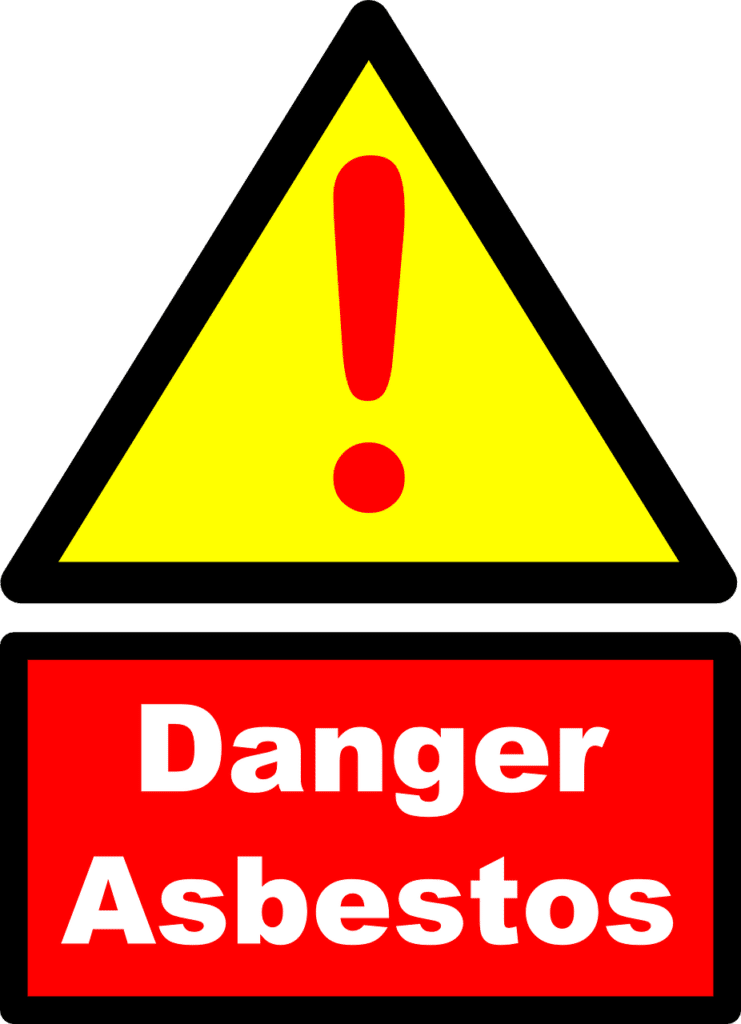
Why Asbestos is Still a Problem?
Although its widespread historical use has now led to its ban, many older buildings still have asbestos present. This legacy asbestos continues posing risks today. Problems include:
- Lack of awareness around asbestos hazards.
- Failure to correctly identify all asbestos materials.
- Improper removal by untrained individuals.
- Deteriorating asbestos that can release fibers.
- Damaging asbestos during renovations or construction.
- Poor monitoring and management of known asbestos.
Regulations Protect Everyone from Exposure
At the end of the day, the Control of Asbestos Regulations aim to protect all individuals from the dangers of it.
While organisations, employers and workers have clear duties mentioned, the rules serve to prevent asbestos-related deaths from this dangerous material.
Compliance ensures public health.
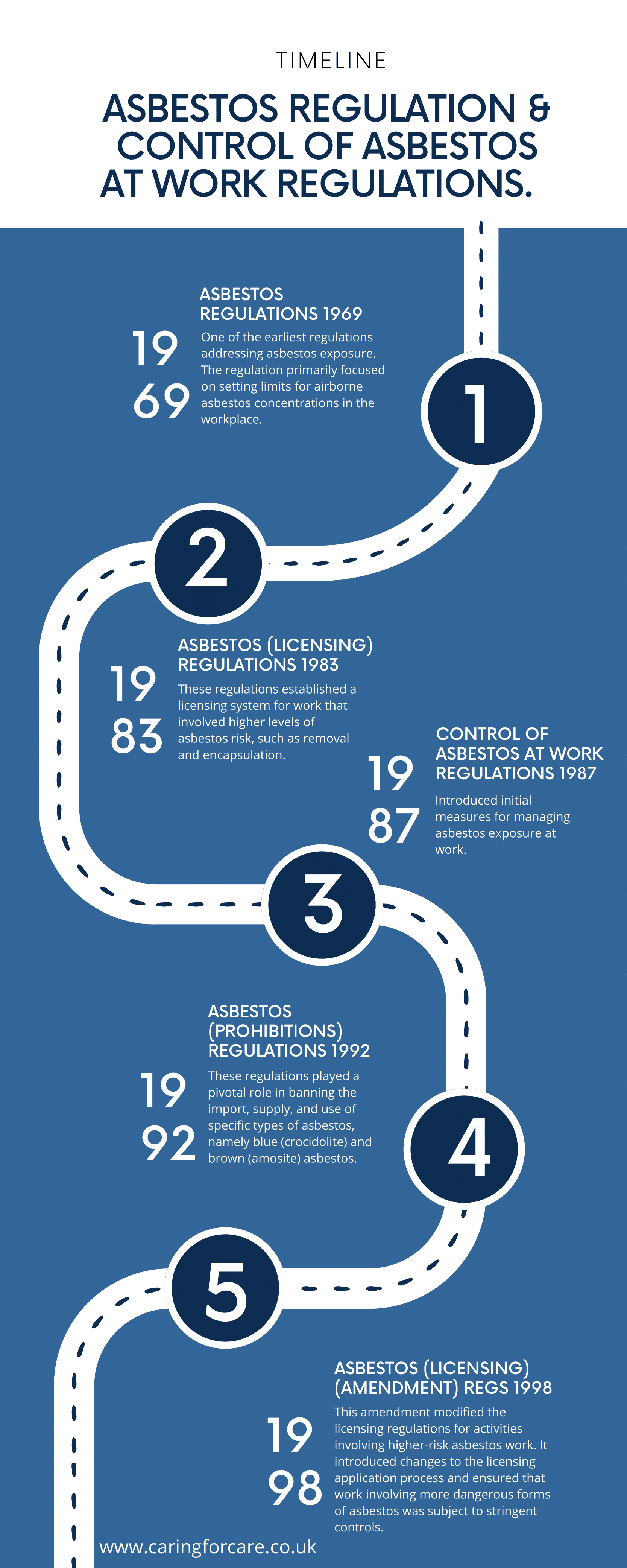
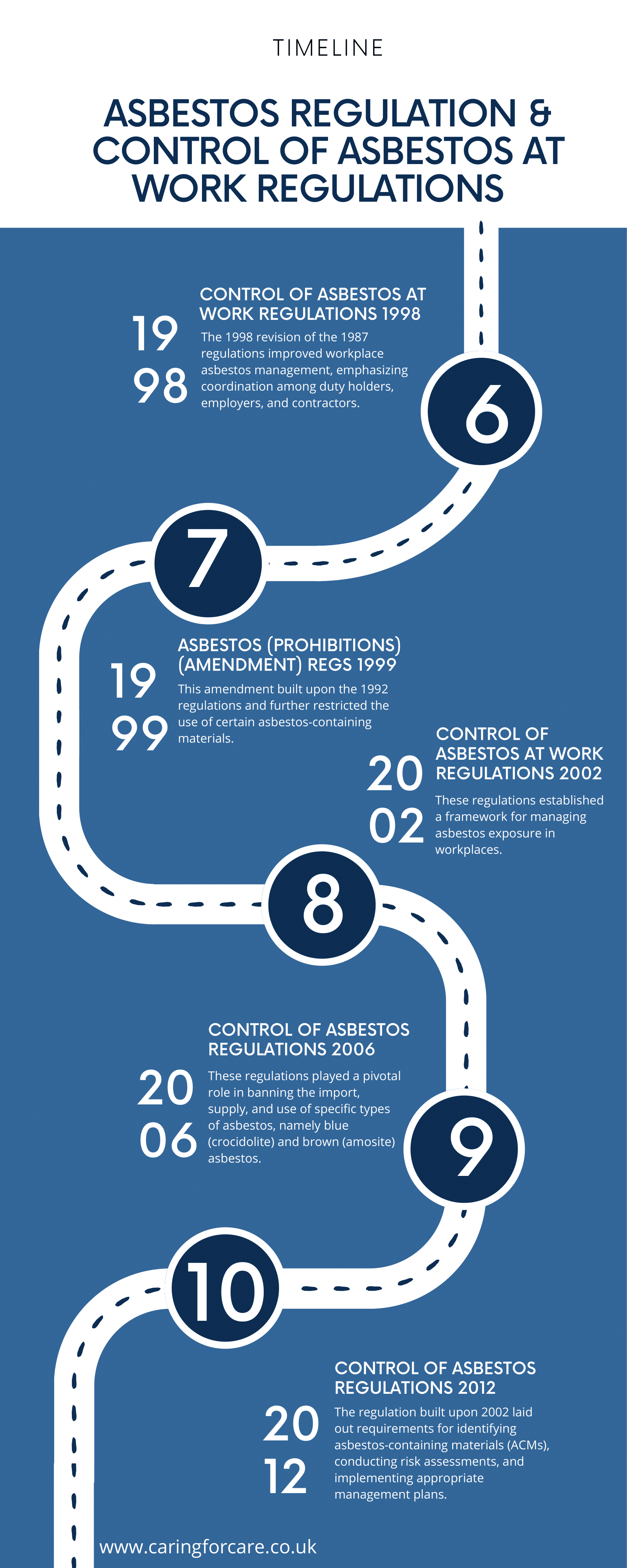
More on Control of Asbestos Regulations 2012
In 2012, the regulators updated the Control of Asbestos Regulations to better align with EU directives on asbestos exposure.
While the regulators kept many requirements the same, they made some changes around non-licensed asbestos work.
Key aspects that stayed the same include needing asbestos management plans, following rules on approved removal work, contact limits, and training requirements.
If sealed and protected, one can leave asbestos in place.
The main changes are:
- Some non-licensed asbestos work now requires notification to relevant authorities.
- For notified non-licensed jobs, the workers must keep brief records. This does not require the workers to perform air monitoring if they can estimate exposure.
- By 2015, workers doing notifiable non-licensed asbestos work need health surveillance by a doctor. This is not required for those already monitored for licensed work.
- Language was modernized and aligned with other chemical safety regulations.
While regulations were updated in 2012, the core responsibilities around licensed work, legal exposure limits, training and management plans remain largely unchanged for duty holders.
Key additions are mainly around reporting and health checks for specific non-licensed tasks.
Previous Asbestos Regulations Before CAR 2012
- Control of Asbestos Regulations 2006
- Control of Asbestos at Work Regulations 2002
- Asbestos (Prohibitions) (Amendment) Regulations 1999
- Control of Asbestos at Work Regulations 1998
- Asbestos (Licensing) (Amendment) Regulations 1998
- Asbestos (Prohibitions) Regulations 1992
- Control of Asbestos at Work Regulations 1987
- Asbestos (Licensing) Regulations 1983
- Asbestos Regulations 1969
Key Highlights of Previous CAR:
- Control of Asbestos at Work Regulations 2002 introduced asbestos management duty for premises. This required identification, risk assessments and management plans for asbestos.
- Asbestos (Prohibitions) Regulations 1992 prohibited supply and new use of asbestos products.
- Asbestos (Licensing) Regulations 1983 introduced the requirement for licensed contractors to undertake most asbestos removal work.
- Asbestos Regulations 1969 first established asbestos exposure limits and regulations around handling and working with asbestos.
The Control of Asbestos Regulations have been periodically updated over the decades to introduce tighter regulations as the dangers of asbestos became more evident.
The latest 2012 version aligned closer with European standards. However, the core responsibilities have largely continued from earlier asbestos regulations in the UK.
In Conclusion
In short, the Control of Asbestos Regulations hand over duties to different groups dealing with asbestos. The main aim is to protect everyone from contact to this harmful material found in many old buildings.
Everyone’s involved, like duty holders, employers, and removal workers, has specific responsibilities. Following the rules is a team effort, ensuring less risk from asbestos through proper detection, training, permission, removal methods, and checking.
These rules focus the importance of staying careful, even years after asbestos was banned.
Ongoing work is needed to manage old asbestos and keep offices and public areas safe for the future.
Important Page Links to Visit
Let us Help you
We’ll help you find the right course for your needs. Tell us a little bit about your situation and what you would like to achieve.
We’ll get back to you within one working day.
